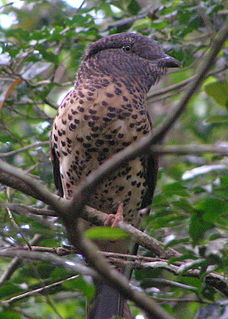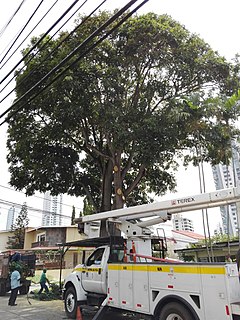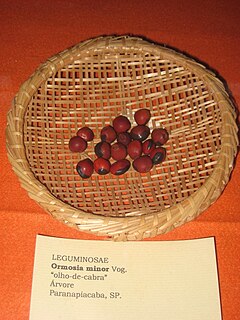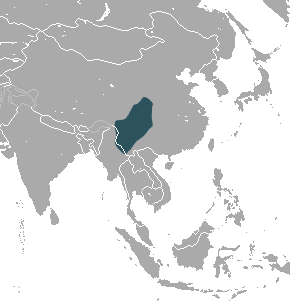
The cuckoo roller or courol is the only bird in the family Leptosomidae, which was previously often placed in the order Coraciiformes but is now placed in its own order Leptosomiformes. The cuckoo roller is at the root of a group that contains the Trogoniformes, Bucerotiformes, Piciformes, and Coraciiformes.

Dipterocarpus gracilis is a critically endangered species of tree in the family Dipterocarpaceae, native to South Asia and Southeast Asia.

The slender yellow bat is a species of vesper bat. It is found only in Mexico.

The black-tailed mosaic-tailed rat is a species of rodent in the family Muridae. It is endemic to the island of New Guinea.

Ormosia cruenta is a species of legume in the family Fabaceae. It is found in Panama and Costa Rica.

Ormosia is a genus of legumes. The more than 100 living species, mostly trees or large shrubs, are distributed throughout the tropical regions of the world, some extending into temperate zones, especially in East Asia. A few species are threatened by habitat destruction, while the Hainan Ormosia is probably extinct already.
Ormosia grandistipulata is a species of tree or shrub in the family Fabaceae. It is endemic to Peninsular Malaysia. It is threatened by habitat loss.
Ormosia hosiei is a species of legume in the family Fabaceae.
Ormosia howii, the Hainan ormosia, is a species of legume in the family Fabaceae native to southern China. It was initially found on Diaoluo Shan, Hainan Island in 1954 and then in Yangchun, Guangdong in 1957, both times in extremely small populations. The species is now apparently extinct. It was a small tree, 10 metres (33 ft) high, growing in open forests on mountain slopes.
Ormosia jamaicensis is a species of legume in the family Fabaceae. It is found only in Jamaica.
Ormosia panamensis, commonly known as coronil or sur espino, is a species of legume in the family Fabaceae. It is found in Costa Rica, Guatemala, Mexico, and Panama.
Ormosia polita is a species of legume in the family Fabaceae. It is a tree endemic to Peninsular Malaysia. It is threatened by habitat loss.

The Talamancan small-eared shrew is a species of mammal in the family Soricidae. It is found in Costa Rica and Panama.

The gracile shrew mole is a species of mammal in the family Talpidae. It is endemic to China; populations known from Myanmar likely represent other species.
Litsea gracilis is a species of plant in the family Lauraceae. It is endemic to Peninsular Malaysia. It is threatened by habitat loss.
Pouteria gracilis is a species of plant in the family Sapotaceae. It is endemic to Peru.
Sloanea gracilis is a species of plant in the Elaeocarpaceae family. It is endemic to Suriname.
Stemonoporus gracilis is a species of plant in the family Dipterocarpaceae. It is endemic to Sri Lanka.
Swartzia panacoco, known as panococo or Brazilian ebony, is a tree of the bean family, growing in Guyana, South America. Its wood is hard and durable. The heartwood ranges from an olive brown to a near black color and can have lighter or darker markings that are sharply separated from the sapwood, which is lighter and yellow in appearance.
The slender tube-nosed bat is a species of vesper bat in the family Vespertilionidae found only in Taiwan.








